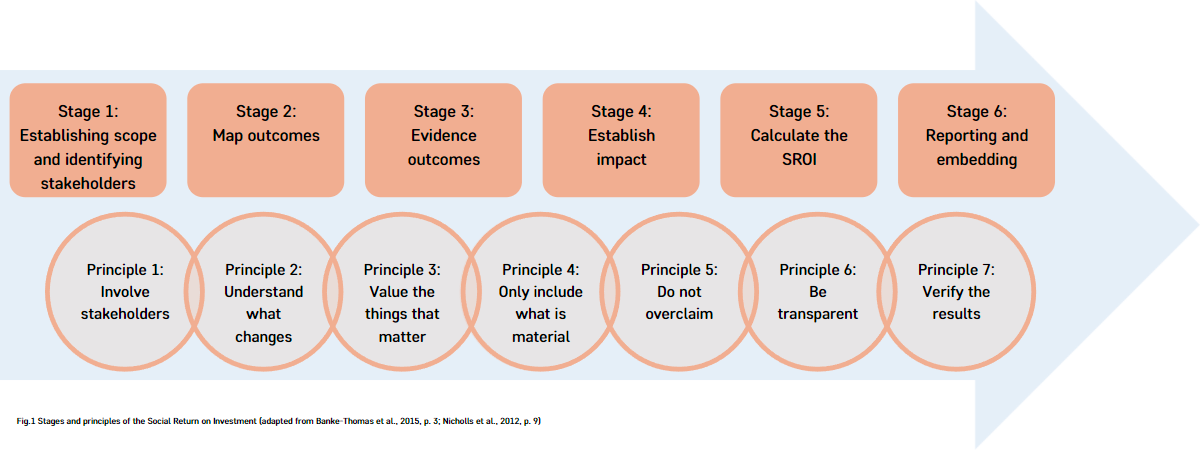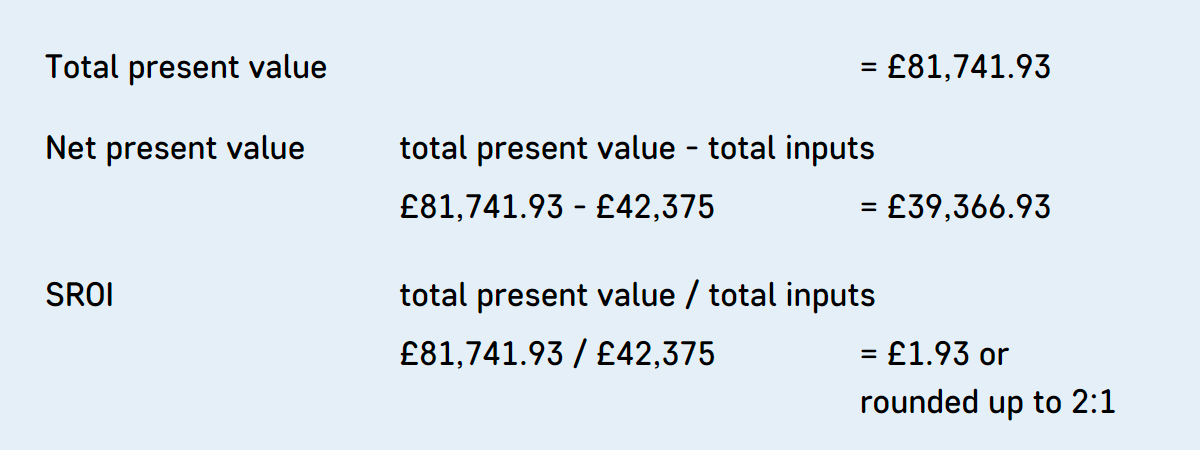In last month’s blog I spoke about a shift in the way we think about our economies, geared towards ‘social value’. This holistic concept of value reflects the complexity of the modern world and the challenges that face society today and tomorrow.
I am using a social value framework – Social Return on Investment – to capture and measure the impact of the Worcestershire Meeting Centres project, which to recap, is the scaling up of a community-based intervention (Meeting Centres) across a county in England.
In this blog I briefly discuss the frameworks strengths and limitations before running through the six stages of SROI. I must say this is an extremely quick whistle stop tour, and much of the nitty gritty has been left out, and as a result I highly advise supplementing the literature at the end of the blog.
Social Return on Investment [SROI]
SROI is a mixed methods framework for measuring and accounting the social value developed by Social Value International. SROI is said to be one of the most widespread social impact tools and is recommended in government policy. It tells a story of how change is being created by measuring outcomes and uses monetary values to represent outcomes. From this the SROI ratio can be calculated, which will sound something like; for every £1 invested £2 of social value is created.
Underpinning SROI are seven principles delivered in six stages (see Figure 1). The stages are explained below, and principles are presented where appropriate in bold italic.

Stage 1 Establishing scope and identifying stakeholders
Stage 1 is where you draw a boundary around what is being considered in the research and identify stakeholders who may experience change. Stakeholders are defined as people or organisations that experience change or affect the activity, whether positive or negative, because of the activity being analysed.
When determining scope it is important to consider: What is the purpose of the SROI? Who is it for? What is the background? What resources do you have available? Who will undertake the SROI? What activities will you focus on? What period of delivery will your analysis cover?
To identify stakeholders, you can simply list all the people/organisations who may experience change, thinking about the intended or unintended changes. The more detailed the notes the easier it is to be transparent about decisions to include/excluded people/organisations in the analysis. The scope should influence the stakeholders, but a key principle of SROI is stakeholder involvement so things like a planning group to decide scope and stakeholders is advantageous.
Stage 2 Mapping Outcomes
Here we begin to fill out the impact map to develop the interventions Theory of Change, which when complete can tell us how the intervention makes a difference in the world.
Engaging with stakeholders enables information to be collected that describes how the activities use certain resources (inputs) to deliver activities (outputs) which result in outcomes for stakeholders. ‘Engaged’ participation (influence research priorities) allows us to appraise the materiality of outcomes, so that we value the things that matter and only include what is material in the analysis.
Stage 3 Evidencing outcomes and giving them a value
At this point outcome indicators are chosen to evidence that outcomes are happening. A mix of subjective and objective indicators will improve the trustworthiness of findings.
Financial proxies can now be applied to outcomes as a way of presenting the relative importance of change to a stakeholder. For example, in a pilot interview a stakeholder of the Worcestershire project felt they had developed knowledge and skills to scale up community interventions that they previously did not have. A financial proxy for this outcome could be the cost of a training course that aims to develop leaders in scaling up. If there is not a proxy value available, you can use Stated Preference and Contingent Valuation techniques.
Stage 4 Establishing Impact
Only when the drop off, deadweight, and attribution rates for each outcome have been considered can we establish impact and reduce the risk of overclaiming.
- Deadweight: is a percentage measure of the amount of outcome that would have happened even if the activity had not taken place. For example, if the activities increased dementia diagnosis rates in a neighbourhood by 7% but there had been a 5% increase in the county during the same period anyway.
- Attribution: is an assessment, presented as a percentage, of how much outcomes were caused by the contribution of activities/people other than the intervention under analysis. For example, people attending the Meeting Centre may also attend a dementia café fortnightly.
- Drop-off: assesses how long outcomes last and is only calculated for outcomes that last more than one year. Unless you have historical data, it can be challenging to apply a drop off rate. Reviewing wider evidence such as academic sources, or by talking to stakeholders and people who have been involved in similar activities in the past can help.
Stage 5 Calculating the SROI
To summarise the financial information into the SROI ratio, we must first calculate the financial value of the investment of the project and the financial value of the costs and benefits. This provides two numbers that can be calculated to provide the net present value [NPV]. For these figures to be comparable a process called discounting is used, where you discount a percentage from the total benefits each year. To get the SROI ratio you divide the discounted value of benefits by the total investment. A worked example used in SROI guidance is provided.

Once you have a ratio you must test the assumptions made in previous stages in a process called Sensitivity Analysis. This process identifies what factors have a significant impact on the overall ratio. There is a standard expectation to test estimates of deadweight, attribution, and drop-off; financial proxies; quantity of the outcome; and value of non-monetised inputs to varying degrees until the SROI ratio presents as 1:1 (£1 value for £1 investment).
Stage 6 Reporting, using, and embedding
Finally, and arguably the most important stage is about reporting to the stakeholders, communicating and using the results, and embedding the SROI process in your organisation for future evaluation.
There may be a variety of different stakeholder groups and communication methods need to reflect this. A SROI report produced should cover all key aspects of the analysis, including the financial accounting and the qualitative data that narrates the projects Theory of Change. The report should also make a set of recommendations for the organisation to develop based on social value.
Lastly, you may wish to verify the results by sending the report, including the data collected throughout the analysis, to be verified by an expert in the SROI.
Ta
Nathan
Link for SROI guidance https://socialvalueuk.org/resource/a-guide-to-social-return-on-investment-2012/
Arvidson, M., Lyon, F., Mckay, S., & Moro, D. (2010). The ambitions and challenges of SROI.
Maier, F., Schober, C., Simsa, R., & Millner, R. (2015). SROI as a Method for Evaluation Research: Understanding Merits and Limitations. Voluntas, 26(5), 1805–1830. https://doi.org/10.1007/s11266-014-9490-x
Hutchinson, C. L., Berndt, A., Forsythe, D., Gilbert-Hunt, S., George, S., & Ratcliffe, J. (2019). Valuing the impact of health and social care programs using social return on investment analysis: how have academics advanced the methodology? A systematic review. BMJ Open, 9(8), e029789. https://doi.org/10.1136/BMJOPEN-2019-029789

Nathan Stephens
Author
Nathan Stephens is a PhD Student and unpaid carer, working on his PhD at University of Worcester, studying the Worcestershire Meeting Centres Community Support Programme. Inspired by caring for both grandparents and personal experience of dementia, Nathan has gone from a BSc in Sports & Physical Education, an MSc in Public Health, and now working on his PhD.

 Print This Post
Print This Post